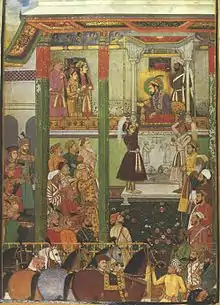Shahjahannama
The Shahjahannama (Chronicle of Shah Jahan) is a genre of works written about the Mughal Emperor Shah Jahan. Padshahnama is a term for lavishly illuminated versions.

The Mughal Emperor Shah Jahan receives Persian Safavid ambassadors in the year 1636, from a Padshahnama.
A significant work in this genre was written by the historian Inayat Khan in the 17th century.[1][2][3] The first complete English translation from Persian appeared in the 19th century by A. R. Fuller.[4]
References
- Kani, Wak (1997). "The Shah Jahan Nama of 'Inayat Khan: An Abridged History". Journal of the Royal Asiatic Society. jstor.org. 7 (3): 466–468. doi:10.1017/S1356186300009652. JSTOR 25183432. S2CID 162937041.
- Khan, Gulfishan. "Shahjahannama-". scribd.com. Retrieved 3 February 2014.
- "Shah Jahan (1875)". 1875. Retrieved 3 February 2014.
- 'Inayat Khan; Wayne Edison Begley (1990). The Shah Jahan nama of 'Inayat Khan: an abridged history of the Mughal Emperor Shah Jahan, compiled by his royal librarian : the nineteenth-century manuscript translation of A.R. Fuller (British Library, add. 30,777). Oxford University Press. ISBN 978-0-19-562489-2.
This article is issued from Wikipedia. The text is licensed under Creative Commons - Attribution - Sharealike. Additional terms may apply for the media files.